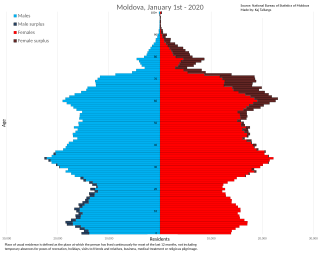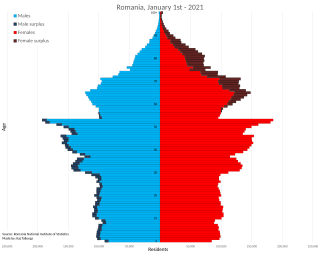Related Research Articles

This article is about the demographic features of the population of Moldova, including distribution, ethnicity, languages, religious affiliation and other statistical data.

Moldova, officially the Republic of Moldova, is a landlocked country in Eastern Europe. It is bordered by Romania to the west and Ukraine to the north, east, and south. The unrecognised state of Transnistria lies across the Dniester river on the country's eastern border with Ukraine. Moldova's capital and largest city is Chișinău.

This article is about the demographic features of the population of Romania, including population density, ethnicity, education level, health of the populace, economic status, religious affiliations, and other aspects of the population.

The economy of Romania is a complex high-income economy with a skilled labour force, ranked 12th in the European Union by total nominal GDP and 7th largest when adjusted by purchasing power parity. The World Bank notes that Romania’s efforts are focused on accelerating structural reforms and strengthening institutions in order to further converge with the European Union. The country's economic growth has been one of the highest in the EU since 2010, with the first half of 2022 seeing an unexpected 5.8% increase.

Bessarabia is a historical region in Eastern Europe, bounded by the Dniester river on the east and the Prut river on the west. About two thirds of Bessarabia lies within modern-day Moldova, with the Ukrainian Budjak region covering the southern coastal region and part of the Ukrainian Chernivtsi Oblast covering a small area in the north.

Lewis County is a county in the U.S. state of West Virginia. As of the 2020 census, the population was 17,033. Its county seat is Weston. The county was formed in 1816 from Harrison County.

Hayden is a town in Gila and Pinal counties in Arizona, United States. According to the 2010 census, the population of the town was 662.

Chesterfield is a town in the U.S. state of Indiana which lies in Union Township, Madison County and Salem Township, Delaware County. The population was 2,490 at the 2020 census. It is part of the Anderson, Indiana Metropolitan Statistical Area.

Chicago's demographics show that it is a large, and ethnically and culturally diverse metropolis. It is the third largest city and metropolitan area in the United States by population, and the city was home to over 2.7 million people in 2020, accounting for over 25% of the population in the Chicago metropolitan area; home to approximately 9.6 million. The racial makeup of the city in 2010 was 45.3% white and within that 45.3%, 12.9% identify as having Hispanic ancestry, 32% black, 5% Asian, and 3% from two or more races. The ethnic makeup of the population is 28% Hispanic and 72% belong to non Hispanic background. English is the primary language of the city, and Christianity account as the predominant faith.
Poverty in Australia deals with the incidence of relative poverty in Australia and its measurement. Relative income poverty is measured as a percentage of the population that earns less in comparison to the median wage of the working population.
Romani people, traditionally Țigani, constitute one of Romania's largest minorities. According to the 2011 census, their number was 621,573 people or 3.3% of the total population, being the second-largest ethnic minority in Romania after Hungarians. There are different estimates about the size of the total population of people with Romani ancestry in Romania, varying from 4.6 per cent to over 10 percent of the population, because many people of Romani descent do not declare themselves Romani. For example, the Council of Europe estimates that approximately 1.85 million Roma live in Romania, a figure equivalent to 8.32% of the population.

The Romanian diaspora is the ethnically Romanian population outside Romania and Moldova. The concept does not usually include the ethnic Romanians who live as natives in nearby states, chiefly those Romanians who live in Ukraine, Hungary, Serbia, and Bulgaria. Therefore, the number of all Romanians abroad is estimated at about 4–12 million people, depending on one's definition of the term "Romanian" as well as the inclusion respectively exclusion of ethnic Romanians living in nearby countries where they are indigenous. The definition of "who is a Romanian?" may range from rigorous conservative estimates based on self-identification and official statistics to estimates that include people of Romanian ancestry born in their respective countries as well as people born to various ethnic-minorities from Romania.

India is a developing nation. Although its economy is growing, poverty is still a major challenge. However, poverty is on the decline in India. According to an International Monetary Fund paper, extreme poverty, defined by the World Bank as living on US$1.9 or less in purchasing power parity (PPP) terms, in India was as low as 0.8% in 2019, and the country managed to keep it at that level in 2020 despite the unprecedented COVID-19 outbreak. According to World Bank, extreme poverty has reduced by 12.3% between 2011 and 2019 from 22.5% in 2011 to 10.2% in 2019. A working paper of the bank said rural poverty declined from 26.3% in 2011 to 11.6% in 2019. The decline in urban areas was from 14.2% to 6.3% in the same period.The poverty level in rural and urban areas went down by 14.7 and 7.9 percentage points, respectively. According to United Nations Development Programme administrator Achim Steiner, India lifted 271 million people out of extreme poverty in a 10-year time period from 2005–2006 to 2015–2016. A 2020 study from the World Economic Forum found "Some 220 million Indians sustained on an expenditure level of less than Rs 32 / day—the poverty line for rural India—by the last headcount of the poor in India in 2013."

Poverty in France has fallen by 60% over thirty years. Although it affected 15% of the population in 1970, in 2001 only 6.1% were below the poverty line.
Abortion in Romania is currently legal as an elective procedure during the first 14 weeks of pregnancy, and for medical reasons at later stages of pregnancy. In the year 2004, there were 216,261 live births and 191,000 reported abortions, meaning that 46% of the 407,261 reported pregnancies that year ended in abortion.
Poverty in Switzerland refers to people who are living in relative poverty in Switzerland. In 2018, 7.9% of the population or some 660,000 people in Switzerland were affected by income poverty. Switzerland has also a significant number of working poor, estimated at 145,000 in 2015.
Poverty in Canada refers to the state or condition in which a person or household lacks essential resources—financial or otherwise—to maintain a modest standard of living in their community.

In the United States, poverty has both social and political implications. In 2020, there were 37.2 million people in poverty. Some of the many causes include income inequality, inflation, unemployment, debt traps and poor education. The vast majority of people living in poverty are less educated and end up in a state of unemployment; higher incarceration rates have also been observed. Although the US is a relatively wealthy country by international standards, poverty has consistently been present throughout the United States, along with efforts to alleviate it, from New Deal-era legislation during the Great Depression, to the national war on poverty in the 1960s and poverty alleviation efforts during the 2008 Great Recession.

In Japan, relative poverty is defined as a state at which the income of a household is at or below half of the median household income. According to OECD figures, the mean household net-adjusted disposable income for Japan is US$23,458, higher than the OECD member state average of US$22,387. Unlike several other modern countries, Japan has no official poverty line, making it difficult to get accurate figures on those suffering impoverished conditions. It was estimated in 2006, using the Employment Status Survey, that 8.2% of regular employees made little enough to be considered working poor. In October 2009, Japan's Labor Ministry released a report which stated that almost one in six Japanese, which would be 22 million people, lived in poverty.
COVID-19 vaccination in Romania started on 27 December 2020. It was announced that the process would be divided into three phases. Medical personnel would be vaccinated first, followed by the population at risk, and finally by the rest of the population. Vaccination was declared free and non-mandatory. As of March 2022, five types of vaccines were authorized to be used in Romania. This is the largest vaccination campaign in the modern history of Romania.
References
- ↑ Dimensiuni..., p. 13
- ↑ Dimensiuni..., p. 14
- ↑ Dimensiuni..., p. 15
- ↑ Al doilea sondaj privind minoritățile și discriminarea în Uniunea Europeană, European Union Agency for Fundamental Rights, 2016